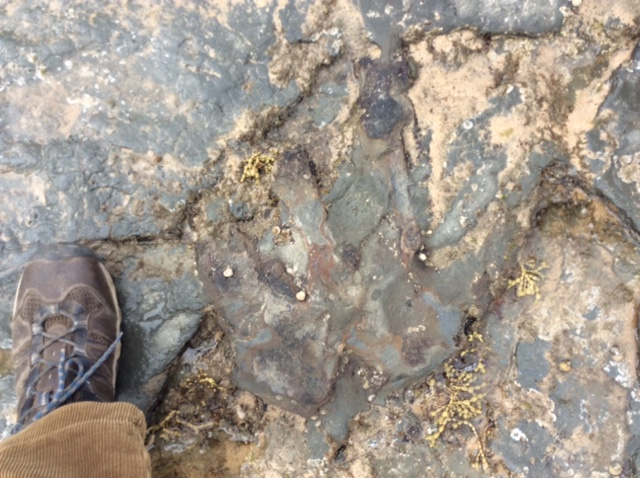Vandals Shatter 115-Million-Year Old Dino Track in Australia
Believed to be from a rare polar dinosaur, the damage was discovered by a school class visiting Bunurong Marine National Park
/https://tf-cmsv2-smithsonianmag-media.s3.amazonaws.com/filer/48/0b/480b5dc2-7e66-4dc0-9cdd-b10f04123e15/dino_track.jpg)
Bunurong Marine National Park was established to protect the delicate coastal and ocean habitats that hug the shores of Victoria, Australia. In the 1990s, researchers found the area protects something else special: traces and remains of dinosaurs. But now, one of these rare fossils has been destroyed. As Kellie Lazzaro at The Australian Broadcasting Corporation reports, sometime in the last month, vandals smashed a 115-million-year-old dino footprint with a hammer, leaving it unrecognizable.
In 2006, the Dinosaur Dreaming paleontological crew from Monash University found the well-defined tracks. Measuring approximately four inches across, the three-toed imprint is believed to belong to an ancient theropod—a group that includes the formidable Tyrannosaurus rex. Instead of chiseling the imprint out of the rock for study, however, researchers decided to make a silicon cast and leave it for visitors to enjoy.
But sometime in the last month, someone destroyed this ancient relic. The vandalism was discovered when a school group hiked out to the site to view the footprint. As Lazzaro reports, rangers could tell right away that it wasn’t natural damage. “The rock there is reasonably hard so it looks like it’s been hit with a hammer and pieces of the rock around the edge of the footprint have been broken away,” Parks Victoria ranger team leader Brian Martin says. “For someone to damage it intentionally, you'd have to have a rough idea of where it is because seaweed grows on the rock platform and it looks like a normal rock until you look closely and see the outline of the footprint.”
The footprint was particularly significant because it was discovered within the Flat Rocks area of the park, one of the only sites in the world where researchers have found the remains of rare polar dinosaurs, Molly Rubin at Quartz reports. About 100 million years ago, around the time when theropods stomped across these lands, southern Australia was much further south, abutting Antarctica, Mitch Leslie wrote for Smithsonian Magazine in 2007. During this time the dino species living on this frosty landmass had to endure periods of darkness up to six months each winter—perhaps even surviving periods of snow and ice.

The polar dinos have raised an enduring question about whether dinosaurs, or perhaps these particular dinosaurs, were warm-blooded. That's something the Dinosaur Dreaming crew has tried to figure out during their annual field seasons working at this site and others along the coast.
Since Australia’s first dinosaur bone was discovered in the park in 1903, Rubin reports, researchers have excavated 6,000 bones and teeth. And it’s possible that this latest footprint isn't entirely lost. Researchers think it could be partially reconstructed.
“The thrill of seeing a real dinosaur footprint has been diminished with the callous act of vandalism,” Bunurong Environment Centre Education Officer, Mike Cleeland says in a press release. “Fortunately, I was able to retrieve some of the broken pieces of the footprint and hopefully the technicians at Museum Victoria may be able to restore the footprint to some degree.”
This isn’t the first assault against paleontology in Australia in recent months. In August, someone hopped the fence at a dinosaur museum in Canberra and used an angle grinder or hacksaw to cut the heads off three large models of velociraptors.
While the Bunurong footprint is out of commission, there are other places to see the impressive tracks of the thunder lizards. Dinosaur Ridge in Morrison, Colorado, has a stretch of 300 theropod and ornithopod tracks—the dinosaur lineages that led to birds—visible along a hike through the area. At the Cretaceous Museum in Bolivia, visitors can see a cliff where a baby T. rex scampered along, perhaps protected by its parents. Some of the best dino tracks are also found in other parts of Australia, including the world’s largest print, which was unveiled by scientists earlier this year at the Dampier Peninsula in Western Australia.